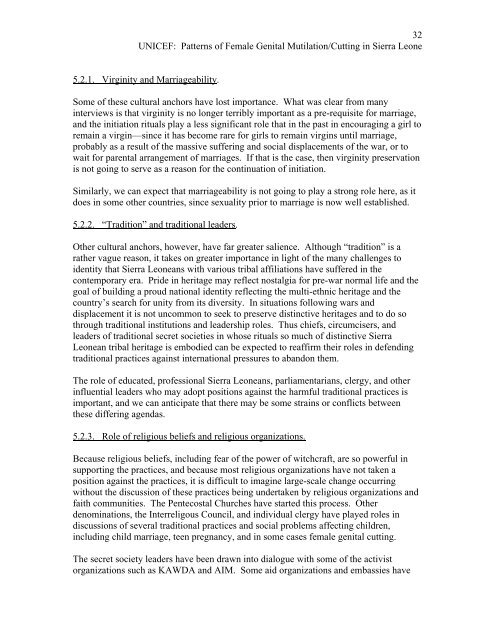Patterns of Female Genital Cutting in Sierra Leone - Unicef
Patterns of Female Genital Cutting in Sierra Leone - Unicef
Patterns of Female Genital Cutting in Sierra Leone - Unicef
You also want an ePaper? Increase the reach of your titles
YUMPU automatically turns print PDFs into web optimized ePapers that Google loves.
32<br />
UNICEF: <strong>Patterns</strong> <strong>of</strong> <strong>Female</strong> <strong>Genital</strong> Mutilation/<strong>Cutt<strong>in</strong>g</strong> <strong>in</strong> <strong>Sierra</strong> <strong>Leone</strong><br />
5.2.1. Virg<strong>in</strong>ity and Marriageability.<br />
Some <strong>of</strong> these cultural anchors have lost importance. What was clear from many<br />
<strong>in</strong>terviews is that virg<strong>in</strong>ity is no longer terribly important as a pre-requisite for marriage,<br />
and the <strong>in</strong>itiation rituals play a less significant role that <strong>in</strong> the past <strong>in</strong> encourag<strong>in</strong>g a girl to<br />
rema<strong>in</strong> a virg<strong>in</strong>—s<strong>in</strong>ce it has become rare for girls to rema<strong>in</strong> virg<strong>in</strong>s until marriage,<br />
probably as a result <strong>of</strong> the massive suffer<strong>in</strong>g and social displacements <strong>of</strong> the war, or to<br />
wait for parental arrangement <strong>of</strong> marriages. If that is the case, then virg<strong>in</strong>ity preservation<br />
is not go<strong>in</strong>g to serve as a reason for the cont<strong>in</strong>uation <strong>of</strong> <strong>in</strong>itiation.<br />
Similarly, we can expect that marriageability is not go<strong>in</strong>g to play a strong role here, as it<br />
does <strong>in</strong> some other countries, s<strong>in</strong>ce sexuality prior to marriage is now well established.<br />
5.2.2. “Tradition” and traditional leaders.<br />
Other cultural anchors, however, have far greater salience. Although “tradition” is a<br />
rather vague reason, it takes on greater importance <strong>in</strong> light <strong>of</strong> the many challenges to<br />
identity that <strong>Sierra</strong> <strong>Leone</strong>ans with various tribal affiliations have suffered <strong>in</strong> the<br />
contemporary era. Pride <strong>in</strong> heritage may reflect nostalgia for pre-war normal life and the<br />
goal <strong>of</strong> build<strong>in</strong>g a proud national identity reflect<strong>in</strong>g the multi-ethnic heritage and the<br />
country’s search for unity from its diversity. In situations follow<strong>in</strong>g wars and<br />
displacement it is not uncommon to seek to preserve dist<strong>in</strong>ctive heritages and to do so<br />
through traditional <strong>in</strong>stitutions and leadership roles. Thus chiefs, circumcisers, and<br />
leaders <strong>of</strong> traditional secret societies <strong>in</strong> whose rituals so much <strong>of</strong> dist<strong>in</strong>ctive <strong>Sierra</strong><br />
<strong>Leone</strong>an tribal heritage is embodied can be expected to reaffirm their roles <strong>in</strong> defend<strong>in</strong>g<br />
traditional practices aga<strong>in</strong>st <strong>in</strong>ternational pressures to abandon them.<br />
The role <strong>of</strong> educated, pr<strong>of</strong>essional <strong>Sierra</strong> <strong>Leone</strong>ans, parliamentarians, clergy, and other<br />
<strong>in</strong>fluential leaders who may adopt positions aga<strong>in</strong>st the harmful traditional practices is<br />
important, and we can anticipate that there may be some stra<strong>in</strong>s or conflicts between<br />
these differ<strong>in</strong>g agendas.<br />
5.2.3. Role <strong>of</strong> religious beliefs and religious organizations.<br />
Because religious beliefs, <strong>in</strong>clud<strong>in</strong>g fear <strong>of</strong> the power <strong>of</strong> witchcraft, are so powerful <strong>in</strong><br />
support<strong>in</strong>g the practices, and because most religious organizations have not taken a<br />
position aga<strong>in</strong>st the practices, it is difficult to imag<strong>in</strong>e large-scale change occurr<strong>in</strong>g<br />
without the discussion <strong>of</strong> these practices be<strong>in</strong>g undertaken by religious organizations and<br />
faith communities. The Pentecostal Churches have started this process. Other<br />
denom<strong>in</strong>ations, the Interreligous Council, and <strong>in</strong>dividual clergy have played roles <strong>in</strong><br />
discussions <strong>of</strong> several traditional practices and social problems affect<strong>in</strong>g children,<br />
<strong>in</strong>clud<strong>in</strong>g child marriage, teen pregnancy, and <strong>in</strong> some cases female genital cutt<strong>in</strong>g.<br />
The secret society leaders have been drawn <strong>in</strong>to dialogue with some <strong>of</strong> the activist<br />
organizations such as KAWDA and AIM. Some aid organizations and embassies have

















